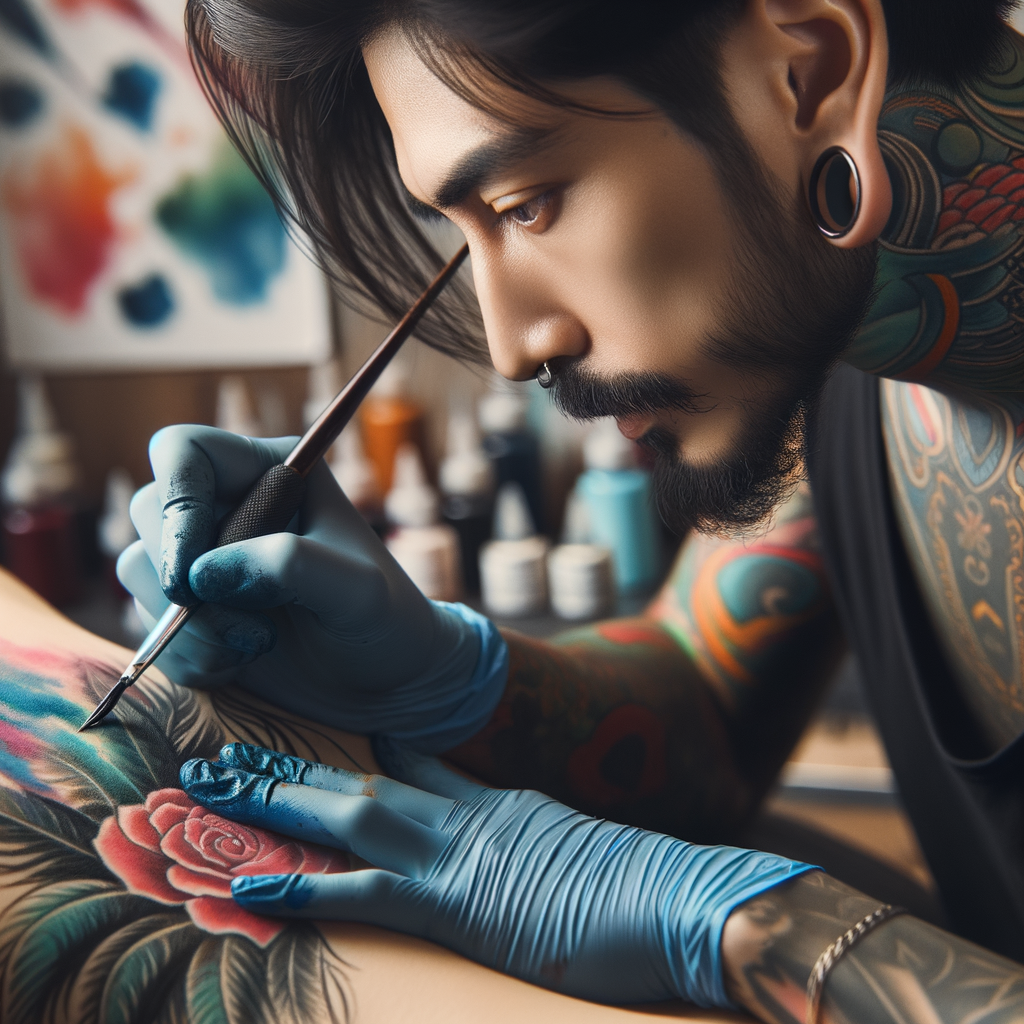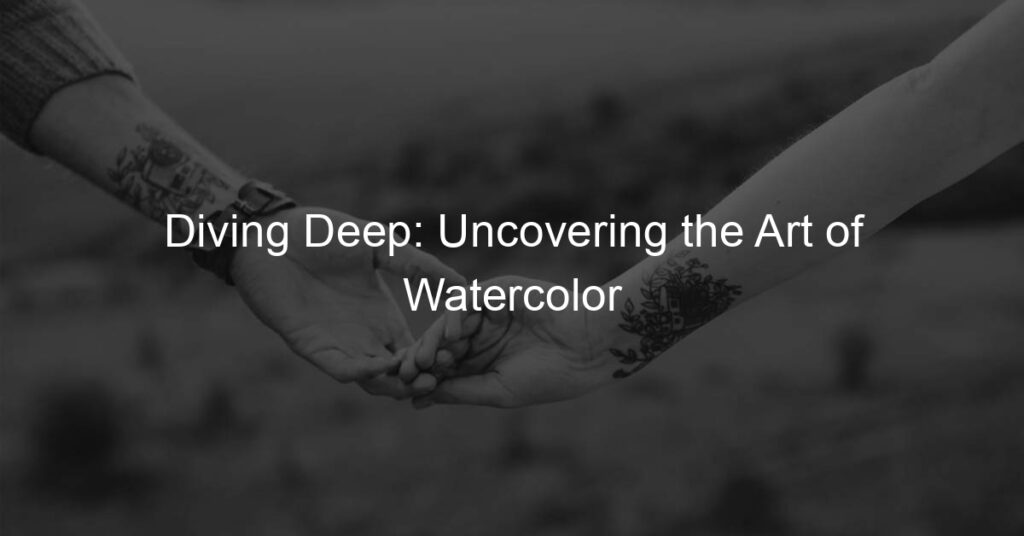
Introduction to Watercolor Tattoo Techniques
Watercolor tattoos have been making waves in the tattoo industry, captivating audiences with their unique blend of color and creativity. This article will introduce you to the world of watercolor tattoos, their rise in popularity, and the artistry behind them.
- The rise of watercolor tattoos
- Understanding the art behind watercolor tattoos
Watercolor tattoos have seen a significant increase in popularity over the past few years. These tattoos, known for their vibrant colors and fluid designs, mimic the look of traditional watercolor paintings. The rise of watercolor tattoos can be attributed to their unique aesthetic appeal and the ability to express individuality through a wide array of color palettes and designs.
Creating a watercolor tattoo requires a deep understanding of color theory, shading, and blending techniques. Unlike traditional tattoos, watercolor tattoos often lack a defined outline, relying instead on color gradients and shading to create depth and dimension. This style of tattooing requires a high level of skill and precision, as the artist must be able to seamlessly blend colors while maintaining the integrity of the design.
Watercolor tattoos are more than just a trend; they are a testament to the evolution of tattoo artistry. As we delve deeper into the world of watercolor tattoos, we’ll explore different styles, techniques, and design ideas to inspire your next tattoo.
Exploring Different Tattoo Styles
When it comes to tattoos, there are numerous styles to choose from. Each style has its unique characteristics and appeal. In this section, we’ll delve into two popular styles: traditional and watercolor tattoos.
Traditional vs. Watercolor Tattoos
Traditional and watercolor tattoos are both beautiful in their own way, but they have some key differences. Let’s take a closer look.
- Comparison of traditional and watercolor tattoo techniques
- Why watercolor tattoos are gaining popularity
Traditional tattoos, also known as “old school” tattoos, are characterized by bold lines and vibrant colors. They often feature iconic designs like roses, skulls, and anchors. The technique involves outlining the design in black before filling it in with color.
On the other hand, watercolor tattoos mimic the look of watercolor paintings. They are known for their soft, blended colors and lack of black outlines. The technique involves applying the ink in a way that creates a gradient effect, similar to how watercolor paint bleeds on paper.
Watercolor tattoos have been gaining popularity in recent years. One reason is their unique aesthetic. Unlike traditional tattoos, watercolor tattoos can create a softer, more painterly look. This can make them appear more like a piece of art than a typical tattoo.
Another reason for their popularity is their versatility. Because they don’t rely on black outlines, watercolor tattoos can be more fluid and abstract. This allows for a wider range of designs and colors, making each tattoo truly unique.
In conclusion, both traditional and watercolor tattoos have their own charm and appeal. It all comes down to personal preference and the kind of aesthetic you want to achieve. Whether you prefer the bold and vibrant look of traditional tattoos or the soft and artistic look of watercolor tattoos, there’s a style out there for everyone.
Brush Stroke Tattoos: A New Trend
As we delve deeper into the world of tattoos, we come across a new and exciting trend that is taking the industry by storm – brush stroke tattoos. This unique style is quickly gaining popularity, and it’s not hard to see why. Let’s explore this trend and see how it differs from the watercolor tattoos we’ve been discussing.
- Understanding the concept of brush stroke tattoos
- How brush stroke tattoos differ from watercolor tattoos
Brush stroke tattoos are a modern and innovative style that mimics the look of brush strokes in a painting. This technique gives the tattoo a dynamic and artistic feel, as if a painter has used your skin as their canvas. The tattoo artist uses varying pressures and angles with the tattoo needle to create the effect of a brush stroke. This style is often used to create abstract designs, but it can also be used to add a unique touch to more traditional imagery.
While both brush stroke and watercolor tattoos are inspired by painting techniques, they are quite different in their execution and final appearance. Watercolor tattoos are known for their vibrant colors and the illusion of paint being spread on the skin, often with a lack of defined lines. On the other hand, brush stroke tattoos focus more on the texture and movement of the brush strokes, often using black and grey ink to emphasize the brush stroke effect. The lines in brush stroke tattoos are more defined, giving the tattoo a more structured look compared to the free-flowing nature of watercolor tattoos.
In conclusion, brush stroke tattoos offer a unique and artistic way to express oneself through body art. Whether you prefer the vibrant colors of watercolor tattoos or the textured look of brush stroke tattoos, both styles offer a unique way to bring art to life on your skin.
Watercolor Ink Art: A Deep Dive
Watercolor ink art is not just a trend, it’s a revolution in the tattoo industry. This unique style of tattooing uses vibrant, flowing colors to create stunning designs that mimic the look of traditional watercolor paintings. Let’s dive deep into the world of watercolor ink art and understand how it’s transforming the tattoo industry.
- Understanding the use of watercolor inks in tattoos
Watercolor ink tattoos are a relatively new style in the world of tattooing. Unlike traditional tattoos that use bold lines and solid colors, watercolor tattoos use a more fluid and vibrant approach. The technique involves using diluted inks to create a soft, flowing effect that resembles a watercolor painting.
One of the key aspects of watercolor tattoos is the use of color gradients and transitions. Instead of the sharp edges and distinct lines found in traditional tattoos, watercolor tattoos often feature soft, blended edges and a range of hues within a single color. This gives the tattoo a dynamic, fluid look that can be incredibly appealing.
It’s important to note that watercolor tattoos require a high level of skill and experience to execute correctly. The artist must have a deep understanding of color theory, shading, and blending techniques to create the desired effect. Additionally, the artist must also consider the longevity of the tattoo, as watercolor tattoos can fade faster than traditional tattoos if not done correctly.
- How watercolor ink art is transforming the tattoo industry
Watercolor ink art is making waves in the tattoo industry for several reasons. First, it offers a fresh, modern take on tattooing that appeals to a younger, more artistic demographic. Many people are drawn to the unique, vibrant look of watercolor tattoos and appreciate the creativity and skill required to create them.
Second, watercolor tattoos offer a greater range of expression for both the artist and the client. The fluid, dynamic nature of watercolor allows for more creativity and individuality in the design process. This can result in truly unique, personalized tattoos that are a reflection of the client’s personality and style.
Finally, the rise of watercolor tattoos is also a reflection of the broader trend towards customization and personalization in the tattoo industry. As more people seek out unique, custom tattoos, the demand for innovative styles like watercolor is likely to continue growing.
In conclusion, watercolor ink art is not just a trend, it’s a revolution that’s transforming the tattoo industry. By offering a fresh, vibrant alternative to traditional tattoo styles, watercolor tattoos are opening up new possibilities for artistic expression and personalization in the world of tattooing.
Tattoo Technique Guide: Mastering Watercolor Tattoos
Watercolor tattoos are a unique and beautiful form of body art. They mimic the fluid, vibrant nature of watercolor paintings, making them a popular choice for those seeking a more artistic tattoo style. This guide will walk you through the steps to mastering watercolor tattoos, from choosing the right design to understanding the process and caring for your tattoo.
Step-by-Step Guide to Watercolor Tattoo Techniques
- Choosing the Right Design for Watercolor Tattoos
- Understanding the Process of Creating Watercolor Tattoos
- How to Care for Your Watercolor Tattoo
Choosing the right design is the first step in the journey to a beautiful watercolor tattoo. Consider designs that lend themselves well to the fluid, vibrant nature of watercolor art. Flowers, animals, and abstract shapes are popular choices. Remember, the design should resonate with you personally, as it will be a permanent part of your body.
Watercolor tattoos are created using a special technique that involves layering colors and using shading to create a watercolor effect. The tattoo artist will first outline your chosen design with a thin black line. They will then fill in the design with a variety of colors, blending them together to create a watercolor effect. This process requires a skilled tattoo artist with experience in watercolor techniques.
Caring for your watercolor tattoo is crucial to maintaining its vibrant colors and overall appearance. After getting your tattoo, keep the area clean and moisturized. Avoid exposing the tattoo to direct sunlight, as this can fade the colors. Regular touch-ups may be necessary to keep your watercolor tattoo looking its best.
Mastering watercolor tattoos requires understanding the unique techniques involved and taking proper care of your tattoo. With the right design and care, your watercolor tattoo can be a vibrant, beautiful piece of body art that you’ll be proud to show off.
Artistic Tattoo Methods: From Concept to Creation
Creating a watercolor tattoo is a unique process that requires both artistic vision and technical skill. In this section, we will explore how to conceptualize your watercolor tattoo design and how to choose the right tattoo artist for your watercolor tattoo.
- How to conceptualize your watercolor tattoo design
- Choosing the right tattoo artist for watercolor tattoos
Conceptualizing your watercolor tattoo design is the first step towards creating a unique piece of body art. Start by gathering inspiration from various sources such as art, nature, or personal experiences. Sketch out your ideas and experiment with different colors and shapes. Remember, watercolor tattoos are known for their vibrant and fluid colors, so don’t be afraid to play with bold hues and gradients.
Once you have a rough idea, refine it by considering the size, placement, and overall aesthetic of the tattoo. It’s also important to think about the longevity of the design. Watercolor tattoos can fade faster than traditional tattoos, so choosing a design that will age well is crucial.
Not all tattoo artists are experienced in watercolor tattoos, so it’s essential to choose an artist who specializes in this style. Look at their portfolio to see if their artistic style matches your vision. Pay attention to their use of color, shading, and line work.
It’s also important to consider the artist’s professionalism and hygiene practices. Tattooing involves breaking the skin, so it’s crucial to choose an artist who maintains a clean workspace and uses sterile equipment. Don’t hesitate to ask questions about their process and safety measures.
In conclusion, creating a watercolor tattoo involves careful planning and choosing the right artist. With the right approach, you can create a beautiful piece of art that is truly unique to you.
Ink and Watercolor Tattoos: A Beautiful Blend
When it comes to the world of tattoos, there’s always something new and exciting to explore. One of the most recent trends that has been making waves is the blend of ink and watercolor. This unique combination has created a whole new genre of tattoo art that is both visually striking and deeply meaningful.
- Understanding the blend of ink and watercolor in tattoos
- How ink and watercolor tattoos are changing the game
Traditional tattoo ink is known for its bold and solid colors. It’s what gives tattoos their iconic, timeless look. On the other hand, watercolor ink is known for its softer, more fluid appearance. It’s like painting on your skin with a brush dipped in watercolor paint.
When these two types of ink are blended together, the result is a tattoo that has the best of both worlds. The boldness of the traditional ink provides a solid foundation, while the watercolor ink adds a touch of whimsy and creativity. The result is a tattoo that is both striking and delicate, bold and soft.
Ink and watercolor tattoos are revolutionizing the tattoo industry. They are pushing the boundaries of what is possible in tattoo art, and opening up new avenues for creativity and expression. These tattoos are not just about the visuals, they are also about the story behind the ink.
For example, a watercolor tattoo of a butterfly might use traditional ink for the outline of the butterfly, and then use watercolor ink to fill in the wings with a burst of color. This could symbolize a personal transformation or a new beginning. The possibilities are endless.
As you can see, ink and watercolor tattoos are a beautiful blend of tradition and innovation. They are a testament to the ever-evolving nature of tattoo art, and a reminder that there is always room for creativity and individuality in this ancient art form.
So, whether you’re a seasoned tattoo enthusiast or a newbie looking to get your first piece, consider ink and watercolor tattoos. They might just be the perfect blend of art and self-expression you’ve been looking for.
Tattoo Art Exploration: Beyond the Basics
As we delve deeper into the world of tattoo art, we discover that there’s more to it than meets the eye. Beyond the basic techniques and styles, there’s a whole universe of creativity and innovation waiting to be explored. One such area is the realm of watercolor tattoos. These tattoos are unique, vibrant, and full of life, making them a popular choice among tattoo enthusiasts.
Case Study: Successful Watercolor Tattoo Designs
Let’s take a closer look at some successful examples of watercolor tattoos and uncover the key takeaways from these designs. By studying these examples, we can gain a deeper understanding of what makes a watercolor tattoo truly stand out.
- Exploring successful examples of watercolor tattoos
One of the most successful examples of watercolor tattoos is a design that incorporates a vibrant splash of colors with a silhouette of a bird. This design stands out due to its clever use of colors that seamlessly blend into each other, creating a stunning visual effect. Another successful example is a floral design where the artist has used watercolor techniques to give the flowers a soft, delicate look.
- Key takeaways from successful watercolor tattoo designs
There are several key takeaways from these successful watercolor tattoo designs. Firstly, the use of vibrant colors is crucial. The more vivid the colors, the more the tattoo stands out. Secondly, the blending of colors is an essential skill in creating a watercolor tattoo. The colors should blend seamlessly into each other, creating a smooth transition. Lastly, the design itself plays a significant role. The design should be unique and meaningful to the person getting the tattoo.
| Key Takeaways | Description |
|---|---|
| Vibrant Colors | The use of bright and vivid colors makes the tattoo stand out. |
| Blending of Colors | The colors should blend seamlessly into each other, creating a smooth transition. |
| Unique Design | The design should be unique and meaningful to the person getting the tattoo. |
In conclusion, watercolor tattoos are a beautiful blend of art and creativity. By understanding the key elements that make a watercolor tattoo successful, you can create your own unique and meaningful design.
Watercolor Tattoo Design Ideas: Inspiring Your Next Tattoo
Now that you’ve learned about the techniques and styles of watercolor tattoos, it’s time to explore some design ideas. Whether you’re a tattoo enthusiast or a first-timer, these watercolor tattoo design ideas will inspire your next tattoo.
- Popular Design Ideas for Watercolor Tattoos
- Floral Designs: Flowers are a common choice for watercolor tattoos due to their natural beauty and variety of colors.
- Animal Designs: From majestic lions to delicate butterflies, animal designs can be beautifully rendered in watercolor style.
- Abstract Designs: For those who prefer a more unique and personal design, abstract watercolor tattoos offer endless possibilities.
- How to Personalize Your Watercolor Tattoo Design
- Choose a Meaningful Subject: Whether it’s a favorite animal, a cherished memory, or a symbol that represents you, choosing a meaningful subject can make your tattoo truly personal.
- Use Your Favorite Colors: Watercolor tattoos are all about color. Choose colors that resonate with you to make your tattoo even more personal.
- Work with Your Tattoo Artist: Your tattoo artist is a professional who can help you create a design that’s uniquely you. Don’t be afraid to collaborate and share your ideas with them.
Watercolor tattoos are known for their vibrant colors and fluid designs. Here are some popular design ideas:
Personalizing your tattoo design can make it more meaningful and unique. Here are some ways to personalize your watercolor tattoo:
Remember, the most important thing about getting a tattoo is that it should be something you love and feel connected to. So, take your time, explore different designs, and make sure your next tattoo is something you’ll be proud to wear.






